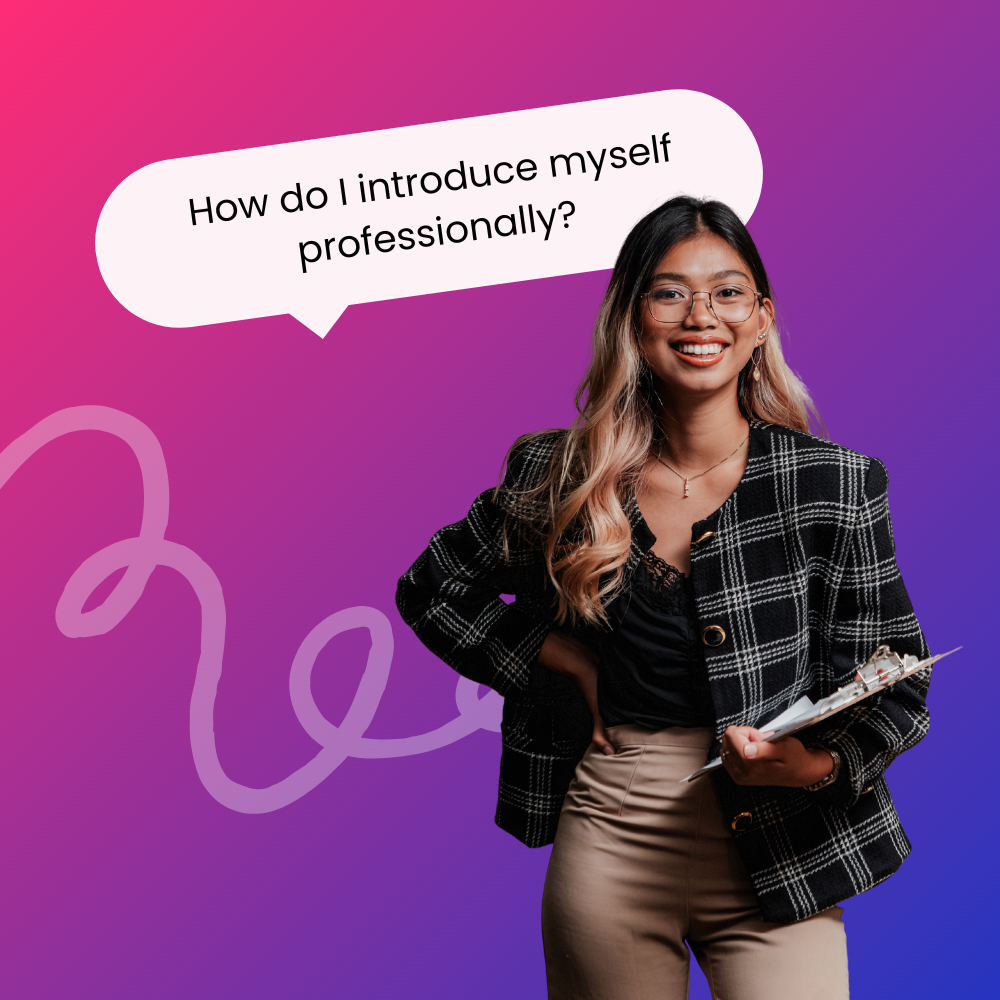How to Introduce Yourself Professionally in 9 Easy Steps

A funny thing happens when you enter the professional world. Actions you never gave much thought to before, like introducing yourself, suddenly take on a new level of importance. How you introduce yourself to a person impacts their perception of you, which can affect everything from your working relationship to how much they trust you and more.
We’ll explain the many ways your introduction influences your professional life and show you how to make a great introduction in 9 simple steps.
The importance of a professional introduction
First impressions are hard to shake
Whether they’re accurate or not, first impressions last a long time. Research has shown that even after we get to know a person, our interactions with them continue to be colored by the first few things we learn about them. What’s more, humans are very reliant on gut instinct. If your gut tells you someone is deceitful from the first time you meet them, you will be much less likely to trust that person than someone who gave you the impression of being truthful.
It’s the first step in establishing relationships
Your introduction helps you form connections with work peers, supervisors, customers, and other professional contacts. A positive introduction creates rapport, sets the tone for a good relationship, and provides a foundation for getting to know the other person better, which is what networking is all about.
A professional introduction sets you up for success
A professional introduction can help you build a strong network. This can be an asset in learning about employment opportunities, landing interviews, and acquiring feedback that can help advance your career. A good introduction helps others like you, fostering a sense of familiarity and trust to facilitate successful collaboration.
How to introduce yourself professionally
1. Smile
Who would you rather approach: someone wearing a scowl or a smile? A warm, genuine smile is one of the fastest ways to make a good impression. An authentic smile exudes confidence and friendliness, which can make others feel more comfortable interacting with you. Smiling also boosts your own self-confidence, helping you put your best foot forward.
2. Make eye contact
Eye contact is a crucial element of nonverbal communication. It tells the other person things about you before you even open your mouth. Making eye contact demonstrates that you’re attentive to and interested in what’s being said, which is a respectful way to handle any new introduction.
To make effective eye contact, look into the other person’s eyes as you approach them and while you introduce yourself. As they introduce themself in return, avoid the feeling of staring them down by switching your gaze between their eyes and other areas of the face, like their mouth. It’s okay (and comfortable) to break eye contact to look away occasionally.
3. Offer a firm handshake
In North America and Europe, a handshake is customary at the start of a business interaction, especially when two people are meeting for the first time. It’s another way of saying “Nice to meet you” and demonstrating professionalism. Use your right hand and grasp the other person’s hand firmly, giving it a short shake before letting go.
4. Start with a polite greeting
Open the introduction with a friendly greeting. “Good morning!” “Nice to meet you.” “How’s it going?” and “I’m excited to be here” are all good examples.
Different settings will require different levels of formality, so you should use your best judgment to decide what statement is most appropriate. When introducing yourself in a job interview, for example, you’ll want to be more formal than you would if being introduced to a friend of a friend at a networking event, where you can use more casual language.
5. Say your full name and role
Using your full name the first time you meet someone is a good idea. Not only does this differentiate you from others who share the same first name, but it will also help them remember who you are in future interactions where your full name appears, like email exchanges. Along with your name, share your job title and a short summary of what you do.
6. Provide context
Depending on who you’re meeting and where you are, it can be helpful to give some additional information. This adds context to the interaction and can help distinguish you while providing material for continued conversation. If you share a mutual acquaintance with someone, drop their name. If you’ve followed the person’s work on LinkedIn, mention a recent post or accomplishment you admired. If you’re interviewing for a job, share how you heard about the opening.
7. Be succinct
Sometimes, introductions are a gateway into a longer conversation. Other times, they happen in passing and only last a few seconds. Be mindful of what type of introduction the situation calls for. You don’t want to be remembered for taking up an uncomfortable amount of time. Avoid giving a drawn-out explanation of your career history or background; instead, save that for later in the conversation or a future time you meet.
8. Practice active listening
Unless you’re being introduced to a large group of people all at once, the person you’re meeting will probably respond to your introduction with one of their own. Listen closely, being careful to take note of their name. Ask follow-up questions to demonstrate interest, like “How long have you been in that role?” or “What brings you to this event?”
After your conversation has ended, it’s helpful to jot down details about the person you’ve met to help you remember them and refer back to before future meetings.
9. Wrap it up gracefully
Conclude your introduction with a warm closing and enthusiasm about the meeting, like “It was great to meet you!” or “I hope to see you at the next event.” If it’s appropriate to exchange contact details, “Let’s keep in touch!” can be a good segue to sharing your business card or email address.
Examples of professional introductions
Job interview
“It’s a pleasure to be here. I’m Jonathan Sanders, and I’m a cybersecurity analyst. My former colleague, Yolanda Robinson, referred me to apply. She had great things to say about working here, so I was excited to learn of the opening.”
New job
“Hi everyone! My name is Sonia Pradskoya, and I’m joining the team as a deputy product manager. I previously worked with Genovalon, where I was an associate product manager for one of their insurance solutions. I’m excited to work with all of you.”
Networking
“Nice to meet you! I’m Peyton Gray. I work in the marketing department at Simon and Finnster. I’ve seen your posts on LinkedIn about using AI in audience targeting. I would love to hear more about that.”
Next steps after a professional introduction
After any first introduction, it’s good form to follow up. Sending an email or connecting on LinkedIn are two good options. This is a chance to thank the other person for their time, act on any next steps you discussed in your conversation, and open the door to a long-lasting, continued relationship. Contact your new contact periodically to check in, share relevant news, and pass along professional opportunities that might interest them.
With a solid introduction to build on, you’ll set the stage for a positive, professional relationship that can benefit both of you, both now and in the future.
You might also like:

